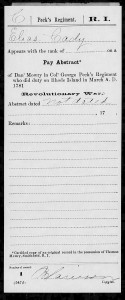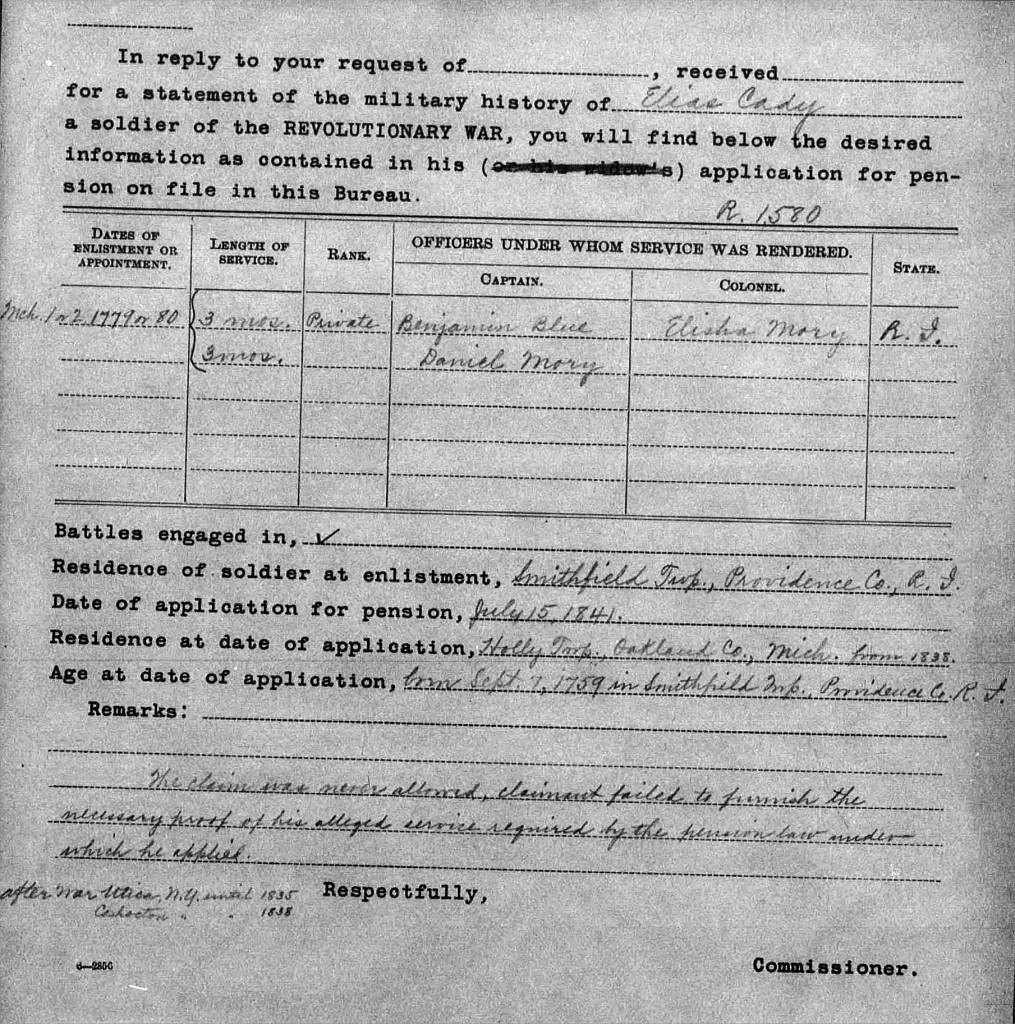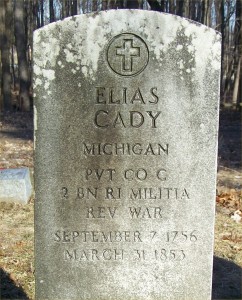Pension File—Fact or Fiction?

The theme for this month’s COG is to tell the story of a document that helped you break through a brick wall in the pursuit of truth in genealogy. I thought about it for a while and realized that, while I have many documents, each has represented only a small step forward. Does anyone ever really break through a brick wall? All I seem to do is run headlong into another one.
What I do have is one document that that changed my approach to family history, Elias Cady’s revolutionary War pension file.

Elias Cady was one of my first “finds” many years ago when I first foolishly stepped into the quicksand that is family history. Twenty years later I’m still flailing around unable to extricate myself.
It all started when Pat and I attended a workshop in beginning genealogy at the New England Historical Genealogical Society. It was there that I learned about Ancestry.com.
I went home, signed up, and there was an enormous chunk of my genealogy, many generations, free for the taking. I had found the public trees of the Blood family and the Cady family, and the Martin family. It was all on the Internet, it must be true, right? I knew nothing about documentation; I knew nothing about anything. I was proud and delighted to have collected all those names and gave little thought to the people those names represented. Time passed. I can’t honestly remember how I chose Elias Cady to hunt down, probably I ran into those famous brick walls with the other objects of my affection.
Elias Cady is a direct ancestor of my husband’s on his father’s side. Norman recalls being told he was eligible for membership in the Sons of the American Revolution at some point. A Revolutionary War ancestor would be interesting, why not take a stab at it?
So it began innocently enough. I started with the census. I needed to get on the train and go to the National Archives branch in New York. The trip was rewarding. The staff was incredibly helpful and I came away with lots of good stuff, including census files, documenting Elias Cady’s life in Michigan from 1840 until his death in1853 at the age of, the age of, well who knows. Later I found a book on Cady genealogy, the DAR service records and some newspaper articles. Then I found the pension file, or at least I thought I did. We’ll come back to that in a minute
There is some confusion about Elias Cady’s date of birth. It is put by various sources between 1757 and 1763 in Rhode Island. 1757 seems possible for Revolutionary War service, 1763, a little more iffy. Then I found a wonderful newspaper article from The Centennial edition of the Holly Herald published in Holly, Michigan. This article published in 1938 celebrates a local hero. It tells us that Elias joined up as soon as the war began in 1776 at the age of 19. He fought at Bunker Hill and showed such bravery that he was chosen to serve in the Guard of the Commander-in Chief. He fought at Washington’s side and waited for him while he interviewed Betsy Ross. He spent the winter at Valley Forge. The article goes on to recount the rest of Elias’ life, telling us that at the age of 90 he rode on a horseback from Michigan to Kentucky to visit an old friend from his war days. It all sounded too fabulous to be true. Hmmm.
I have family in Rhode Island, so on my way to visit them I stopped at the Rhode Island Historical Society where a copy of the pension file was rumored to live. I was handed the file, a single page the last sentence of which read: “claim was never allowed, claimant failed to furnish necessary proof of service.”
After the grandiose claims in the Holly Herald, my husband and I decided that the old man had made all of the stories up to gain some admiration from his family and his neighbors. We found the whole thing rather amusing.
More years passed and for some reason I started looking for more about Elias Cady. It was then that I realized there was more to the pension file, forty pages more. These forty pages paint a rather different picture. It must also be said that twenty years later I see things differently than I did when I first saw the last page of the pension file. The file contains Elias’ sworn statement detailing his service, beginning in 1779 and lasting for 6 months. Yes, many of his claims seem to be highly fictionalized, but what of his actual service? His statement says he served for six months. Six months is an important number. Those who served less than six months were not eligible for a pension. So what of those six months? The file contains supportive letters from those who knew him. There is one letter of a fellow soldier who says Cady served for six months in Rhode Island. There is Elias Cady’s explanation of why he had no discharge papers, “the paymaster, whose name was Shippy ran away and so this deponent got neither his pay nor his discharge.” So Elias Cady was left with his own sworn statement, one letter from a fellow soldier, many letters in support of his character, and no paper trail to prove his service. The letters in his file do state that Elias was old, partially blind, and otherwise debilitated. Ultimately he hired a lawyer who wrote,” He has been endeavoring for many years to obtain a pension to which he believes he is justly entitled, but as yet he has never received a cent and does not know in fact whether his pension has been acted upon or not. Mr. Cady has heretofore sent on to Washington various documents, affidavits, etc. to document his claim. He is one of that band of patriots who fought and suffered in the try times of “76” in the struggle for our National Independence. He is now about 89 years of age and in circumstances of actual poverty- tottering down to his grave without the acknowledgement of a nation’s gratitude which other soldiers of the Revolution have recieved.” It goes on to speak of Elias’ discouragement in regard to the pension.
I look at this story now and see a needy old man denied help. I am hopefully not yet “tottering down to my grave”, but I am much more sympathetic to the needs of impoverished, elderly people than I was when I started searching for Elias Cady’s story.
Is this the story of a veteran denied help by his government in time of need or is it the story of a man who bragged of service he never performed? I will probably never know. Perhaps there is a bit of both, real service, however brief, followed by years of telling a grander story. For me this story has evolved from a cause for gentle laughter to a sad tale of an old and helpless man trying to get help that was desperately needed. And for this genealogist it has been a lesson in looking behind the names to find the real people who shaped our families and our world.

Hi Angela,
I’m sorry for the slow reply; you got caught in my spam filter somehow. The relationship is extremely distant. Nicholas Cady, who emigrated around 1640 had 5 sons. My husband is descended from Nicholas. Your Stanton is probably Stanton Cady born in 1830 reside for some time in Ossining, NY descended form Daniel Cady.
Since he’s not a relative you are probably not interested, but if you are you could have a look at The Descendants of Nicholas cady of Watertown Mass.
Judy
You wouldn’t be related to Stanton Cady by any chance would you? He was a business partner of my husband’s ggg-grandfather, Dudley Emerson Jones in Keokuk, Iowa, between 1855 and 1864 – “Cady, Jones & Peck, Hardware, Cutlery, Mill Goods, &c.” . Stanton (as well as the other partners) are listed in the 1859 Keokuk City Directory, at the Lee County Genealogy page – http://iagenweb.org/lee/data/1859/1859idx.htm. We suspect Cady was either a family friend or relative originally from New York – but we don’t know. Peck was a cousin of Dudley’s wife.
Thanks for posting – interesting article.
Hi,
I looked at some reviews and it looks like an interesting book. Family history always draws me in to the larger history of our nation and the world.
Judy
I am in the midst of reading The Shoemaker and The Tea Party by A.F. Young. There were two different pieces of legislation about the pensions. Initially, you needed two years of service to qualify, but in 1832, that changed to six months. Newspapers were notorious for sharing whatever oral “history” they might get from an old vet.
I could sure use that time machine. I believe Elias Cady took his secrets with him to the grave.
Judy
Wow, what a tale. Don’t you just wish for a time-machine so you can actually see what was real and what wasn’t?
A great post!
At least he left a paper trail for future genealogists, even though it didn’t help him. That he lived in an area of Michigan not far from where I grew up made the story even more interesting to me. Great post.
Cathy
Thank you so much Dan. I proofread and proofread and proofread and I still don’t get it right. Pat’s away so I didn’t have her help with the editing.
Judy
Nice story! I’ve felt sorry for a few Revolutionary War pension applicants that were turned down but the bragging does add quite a bit to this tale.
One correction though, after writing about dates in the 1800’s you missed shifting gears to write about the 1700’s when you wrote about the war. Thought you’d like know.
Thanks for the story,
Dan